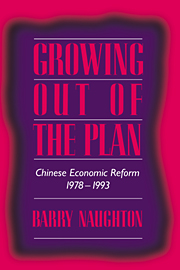Book contents
- Frontmatter
- Contents
- Tables and figures
- Preface
- Introductory
- Phase one The bird in the cage, 1979–1983
- Phase two Reforms take off, 1984–1988
- Phase three To a market economy
- 8 The post-Tiananmen cycle of retrenchment and renewed reform
- 9 Conclusion: Lessons and limitations of the Chinese reform
- Statistical appendix
- Notes
- Bibliography
- Index
8 - The post-Tiananmen cycle of retrenchment and renewed reform
Published online by Cambridge University Press: 03 May 2010
- Frontmatter
- Contents
- Tables and figures
- Preface
- Introductory
- Phase one The bird in the cage, 1979–1983
- Phase two Reforms take off, 1984–1988
- Phase three To a market economy
- 8 The post-Tiananmen cycle of retrenchment and renewed reform
- 9 Conclusion: Lessons and limitations of the Chinese reform
- Statistical appendix
- Notes
- Bibliography
- Index
Summary
The events at Tiananmen Square in June 1989 marked a watershed in China's political evolution and in the worlds perception of China. Ending a period of gradual liberalization and inaugurating one of renewed political repression, Tiananmen shattered the benevolent image of steady progress that the Chinese government had presented to the world. The hardliners who consolidated their power around the Tiananmen incident initially attempted to roll back both economic reforms and political liberalization. During 1989, they began to carry out a program of recontrol of the economy that would have reversed many of the achievements of the previous decade of economic reform. But this program failed. As failure became evident, the hardline leadership backed away from the main elements of the program of recontrol and then gradually discarded it. By late 1990, a renewed search for practical reform measures was evident, and the momentum of reform accelerated through 1992. The years 1992–93 emerged as a new period of significant reform, and the achievement was punctuated by the implementation of important reforms on January 1, 1994. In the economic arena, then, Tiananmen did not mark a sustained shift to more conservative policies. Instead, it merely touched off one more cycle of retrenchment followed by renewed growth and reform. By the end of 1993, dramatic advances in reform had occurred, and economic growth had accelerated to new peaks. Indeed, a number of the politically most difficult reforms that had been stumbling blocks in the past were successfully adopted during this period.
- Type
- Chapter
- Information
- Growing Out of the PlanChinese Economic Reform, 1978–1993, pp. 273 - 308Publisher: Cambridge University PressPrint publication year: 1995



